Tom's Hardware Verdict
Alienware's Aurora R13 is an attractive, capable and quiet gaming PC with lots of front-panel USB ports. We just wish it had better CPU cooling for serious productivity tasks.
Pros
- +
Very quiet when gaming
- +
Lots of convenient front IO
- +
Capable gaming and bursty productivity performance
Cons
- -
120mm CPU cooler limits time-intensive productivity performance
- -
Custom parts complicate upgrades
Why you can trust Tom's Hardware
With AMD's Ryzen 7000 CPUs, Intel's 13th Gen Raptor Lake, plus new high-end GPUs from both Nvidia and AMD seemingly right around the corner, right now may not be the best time to buy a new gaming desktop. Then again, if you've been waiting years to buy a gaming rig thanks to GPU availability issues surrounding crypto mining and the pandemic, you might be pretty sick of waiting. And it seems highly likely that we'll only see fresh graphics cards on the very high-end ($900 plus) this year anyway.
For those who care more about getting a gaming rig now than waiting for reasonably affordable next-gen parts to become available, Alienware's Aurora R13 is an attractive, powerful option. Its primary downsides are a 120 mm all-in-one cooler that, while sufficient for gaming, doesn't handle heavy CPU workloads well on higher-end Alder Lake CPUs. Also, as we'll detail later, stock of our $3,450 MSRP review model (with a Core i7-12700KF, 64GB of RAM, 4TB of storage and an RTX 3080) was not available when we wrapped up this review. But an RTX 3080 Ti model with otherwise the same specs was selling for $90 less ($3,359). Check our Alienware promo codes to see if we can help you shave a few dollars off those prices.
Alienware Aurora R13 Specifications
| Processor | Intel Core i7-12700KF |
| Motherboard | Custom Alienware Z690 (0C92D0) |
| Memory | 32GB DDR5 (4400 MHz) |
| Graphics | OEM RTX 3080 (10GB GDDR6X,1710 MHz Boost Clock) |
| Storage | 2TB Samsung PM9A1 PCIe 4.0 NVMe M.2 SSD; 2TB Hard Drive |
| Networking | Killer E3100 Gigabit Ethernet, Killer Wi-Fi 6 AX1675x, Bluetooth 5.2 |
| Front Ports | 3x USB 3.2 Gen 1 Type-A (5Gbps) ports, 3.2 Gen 2 Type-C (10Gbps) USB Type-C port, 3.5 mm headphone/mic combo audio jack |
| Rear Ports (Motherboard) | 4x USB 2.0 ports, 2x USB 3.2 Gen 1 Type-A (5 Gbps), USB 3.2 Gen 2 Type-C (10 Gbps), USB 3.2 Gen 2 Type-C (20 Gbps), Gigabit Ethernet, 6x analog audio jacks, 2x SPDIF digital audio (TOSLINK, coax) |
| Video Output (GPU) | 3x DisplayPort 1.4a, HDMI 2.1 |
| Power Supply | 750W 80 Plus Platinum |
| Cooling | 120 mm AIO CPU cooler/exhaust, 3x 140 mm fans (2x front intake, 1x top exhaust) |
| Case | Alienware Aurora R13 |
| Operating System | Windows 11 Home |
| Dimensions | 20.1 x 23.2 x 8.86 inches / 510 x 589 x 225 mm |
| Price as Configured | $3,450 (as configured) |
Design of the Alienware Aurora R13


In terms of aesthetics, either you like Alienware's "Legend 2.0" design language, or you don't. Personally, I think it's an improvement over the boxier Aurora R11 we looked at a couple years ago. There is undoubtedly lots of plastic wrapped around the chassis' internal steel. But the plastic at least feels rigid and of high quality. If you don't like white (the company calls it "lunar light") there is also a black/dark gray "dark side of the moon" option that in most configurations seems to cost $50 less.
The Aurora's case, once again, has the motherboard and other components angled upward. And Alienware really anchors down their GPU, with both a plastic bracket on the side and a metal support arm holding up the end of the card. If you're the type who takes your desktop with you to LAN parties (or perhaps just college), this will make damage due to the weight of the graphics card much less likely.
The primary downside of the Aurora's design is parent company Dell's continued use of proprietary parts. The motherboard here has an L-shaped protrusion that sticks out of the front, presenting the plethora of USB ports there. And while it's unlikely that more than a small percentage of Aurora buyers are likely to, at some point, want to swap out their motherboards, the power supply that sits below the motherboard and GPU is also non-standard (at least for consumer PCs. Dell is using a server PSU). So if during the life of the system it fails or you need more power than the 750W available in our review unit (which you very well might with future high-end graphics cards and CPUs), that means at the very least you'll need to get a new power supply from Dell rather than buying a standard ATX supply off the shelf of an online or brick-and-mortar store. At a time when competitor HP and its Omen lineup (seen most recently in the Omen 45L) has moved steadily toward standardized, name-brand parts for a couple years now, it's past time for Dell/Alienware to do something similar.
Another area that's in sore need of a design upgrade is CPU cooling. Intel's Alder Lake CPUs, particularly on the high end, are notoriously tough on coolers. It’s likely their Raptor Lake replacements will be kindred in that regard,. Aand AMD's Ryzen 7000 CPUs look to be similarly thermally taxing. But the current Aurora's cooler tops out with the 120 mm AIO that shipped with our review unit. And that won't change without a case redesign because there's no place for a larger radiator in the current chassis.
Ports and Upgradability of the Alienware Aurora R13
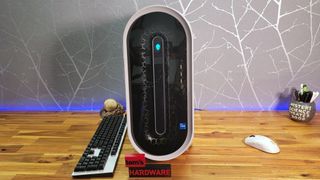
Alienware's Aurora R13 features more convenient front-mounted ports than most desktops. You get three 5 Gbps USB Type-A ports and a 10 Gbps USB Type-C port, alongside a single headphone/mic combo jack.
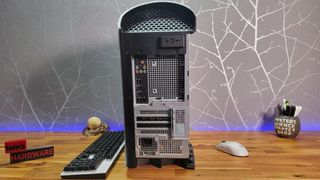
Around back, there are six analog jacks, along with optical in both TOSLINK and coax forms (for just about any conceivable audio connection option). Also there are four USB 2.0 Type-A ports (two with what Dell calls "smart power" for charging your gadgets) and two blue USB 3.2 Gen 1 (5 Gbps) ports. Also around back are two – twice as many as we commonly see – USB Type-C ports, one of the 20 Gbps variety and one that runs at 10 Gbps. Last up is a gigabit Ethernet jack, powered by Killer (E3100). Wi-Fi 6E comes from a card on the motherboard.
The custom motherboard lacks any video ports, but the RTX 3080 GPU brings the usual three DisplayPort 1.4a ports and a single HDMI 2.1. And aside from the occupied M.2 slot in our review unit (sporting a 2TB Samsung PCIe Gen 4 SSD), the board has a second empty NVMe M.2 slot next to the Wi-Fi/Bluetooth card, near the front of the motherboard/case. And aside from the 2TB 3.5-inch hard drive that came with our system, there is an empty 2.5-inch hard drive/SSD sled in the bottom front, along with two unoccupied SATA ports on the motherboard.

Looking at other aspects of internal expandability, you can double up the DDR5 RAM (32GB in our review unit), or swap out the two sticks here for a maximum 128GB total in the four slots. There's also a closed-end PCIe x4 slot above the graphics card, but whatever card you consider putting in there will have to be single- slot, and shouldn't get too warm as it will be sitting right above the GPU. All in all, for a compact mid-tower from a big-box PC maker, the expandability here is pretty good.
Gaming Performance on the Alienware Aurora R13
While Nvidia's next-gen, high-end Ada GPUs are arriving shortly in the form of the expensive RTX 4090 and a pair of 4080s (with an AMD RDNA 3 announcement also coming in early November), the RTX 3080 in our Aurora R13 configuration is certainly no gaming slouch. I played Tiny Tina's Wonderlands at ultra settings on my 4K monitor and averaged just under 60 fps (59.83, to be precise). While that was enough for the game to feel smooth and plenty playable for me, you could of course dial down or turn off one or two settings, or lower the resolution to improve frame rates. That being said, the other desktops we've tested lately have even more gaming muscle than our configuration of the Aurora. Falcon Northwest's compact Tiki tower paired an AMD Ryzen 5800X3D with an RTX 3080 Ti, while HP's bigger (and better cooled) Omen 45L packed a Core i9-12900K and an RTX 3090. Lastly, Corsair's One i300, another compact power tower, combines an i9-12900K with a 3080 Ti (and liquid cools both the CPU and GPU). All of these systems as tested sell for $1,000 or more than our Aurora review unit. The MSRP of our unit is technically $3,450, but the RTX 3080 option is currently not in stock (and it's unclear whether it will come back in stock again). But when we wrote this, the same configuration as our unit, but with a more powerful RTX 3080 Ti, was selling for $3,359.
It's also worth mentioning that the Aurora R13 was very quiet when gaming, which I wasn't necessarily expecting given the 120 mm AIO that the company uses to cool the CPU. That said, as we'll touch on later, the cooler gets quite loud when you heavily stress the CPU for any sustained length of time.





On the Shadow of the Tomb Raider benchmark (highest settings), the Aurora R13 delivered a butter-smooth 155 frames per second (fps) at 1080p, and landed just two frames shy of 60 fps at 4K. That's 16 fps behind the Falcon Northwest and Corsair systems at 1080p, but just 5-8fps shy of all the pricier competition at the higher 4K resolution.
In Grand Theft Auto V (very high settings), the Aurora R13 performed similarly, delivering 171 fps at 1080p and 56 fps at 4K. It was further behind the competition at 4K here, with the compact Tiki delivering 11 more fps at that resolution.
In Red Dead Redemption 2 (medium settings), the Alienware once again dipped 8-12 fps behind the competition at 1080p, while still managing a respectable 113 fps. Its 44 fps at 4K put it 6-10 fps behind its pricier peers.
On the Far Cry 6test, the Alienware arguably looked its worst, lagging 14-53 fps behind at 1080p and 32-34 fps behind its competitors at 4K. Still, at 128 fps at 1080p and 74 fps at 4K, this game still runs extremely smoothly on our configuration of the R13.
Last up in Borderlands 3 (badass settings) the Alienware Aurora R13 managed 141fps at 1080p and 59fps at 4K. That puts it 22 fps behind the Tiki at 1080p and 10 fps behind that system at the higher resolution.
We ran our typical Metro Exodus stress test on the Alienware Aurora R13, simulating a half-hour of gaming by looping the benchmark 15 times. We were curious about how hot the Core i7 CPU would get with just a 120mm AIO cooling it, but we saw an average CPU package temperature of just 64.84 degrees Celsius, with one brief peak at 82 degrees C. That's far from the 100 degrees C you'd need to hit for the CPU to throttle. And frame rates were also extremely consistent on this test, with a high average of 60.29 frames per second (fps) on the second run and a low of 60.21 fps.
That being said, if you're hoping to do serious CPU-hammering tasks with your Core i7 CPU, the cooling here isn't adequate. When running our Cinebench R23 stress test, temperatures approached 100 degrees Celsius within a matter of seconds, and the CPU throttled down to keep temperatures under control. This both limits your performance and means the cooler gets very loud. Again, this isn't an issue when gaming, and most Alienware buyers are going to primarily interested in gaming. But considering Alienware doesn't offer a larger cooling option, you should opt for another system if you want to do lots of video editing or other time-consuming CPU tasks. And if gaming is your primary concern, you're better off opting for a Core i5 model and spending more on the graphics card and/or fast storage for games, anyway.
Productivity Performance on the Alienware Aurora R13
With a Core i7-12700KF CPU, 32GB of RAM and a 2TB PCIe 4.0 SSD, this R13 is a capable work and media crunching machine as well. But as we just discussed, the 120mm AIO cooler isn't a great choice here for longer CPU-heavy workloads. Let's see how the system did in our productivity tests. Once again, note that the competing systems below in our charts have higher-end Core i9 CPUs, save for the Tiki with its gaming-focused 3D V-cache-carrying Ryzen 7 5800X.
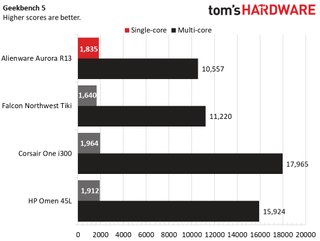
On Geekbench 5, the Aurora's single-core score of 1,835 impressed, easily beating the Tiki's 1,640 and not lagging too far behind the two Core i9 systems. But on the multi-core side, the R13's 10,557 wasn't enough to beat any system here, with the liquid-cooled Corsair One delivering 17,965, or about a 70% improvement over the Aurora.
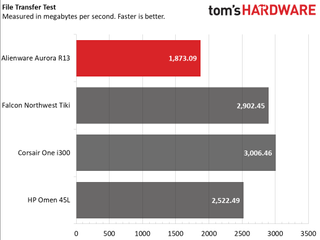
The Aurora's PCIe 4.0 Samsung SSD was fast in our testing, moving our 25GB of files at a rate of 1,873 MBps. But all the other systems here were even swifter, with both the Tiki and One i300 systems hovering around the 3,000 MBps mark. I do like that this configuration of the Aurora ships with both a 2TB SSD and a 2TB hard drive, letting you store lots of games and files. Last up on our Handbrake test, which transcodes a 4K video to 1080p, the Alienware R13 finished the task in 3 minutes and 50 seconds. That was more than fast enough to leave the Tiki in the dust (4:55). But as expected, the Corsair (3:28) and HP (3:39) were faster with their liquid-cooled Core i9 CPUs.
Software and Warranty of the Alienware Aurora R13
Alienware pleasingly delivers little in the way of software cruft with the Aurora R13. There's a bit of the typical Windows 11 bloat, like Spotify and Xbox, but even that is fairly light. Apart from that, there's the Alienware Command Center for lighting, cooling controls and monitoring, as well as functioning as a game launcher. And the Killer app lets you tweak wired/wireless network controls and settings. That's, pleasingly, all you get apart from the Windows 11 Home OS.
Alienware sells the Aurora R13 with a 1-year warranty. You can add longer coverage for $149 for an extra year and $100 per year after that at purchase (up to 4 years).
Configurations of the Alienware Aurora R13
Dell sells the Alienware R13 starting at $1,199 with an RTX 3050, a Core i5-12400F, 16GB of RAM and a 512GB SSD. When we wrote this, there was also a version with a GTX 1650 Super, 8GB of RAM and a 256GB SSD for about the same price, indicating the 3050 model with twice the RAM and storage is likely on sale. A top-end option with a Core i9-12900KF, an RTX 3090, 64GB of RAM and a 2TB SSD sells for $3,749.
Frustratingly, when we wrote this, our review configuration with a Core i7-12700KF, 32GB of RAM, 2TB of SSD storage, a 2TB hard drive and an RTX 3080 was not in stock. In fact, there were no models with an RTX 3080 available on Dell's site–though there were configurations with RTX 3070 Tis and RTX 3060 Tis. It's unclear if the 3080 model will come back in stock, but with the 4080 starting at a high $899, it's clearly not a direct replacement for the previous-gen RTX 3080. Nvidia, at least, says the 3080 will remain in its lineup for now.
Bottom Line
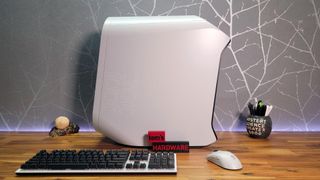
The Alienware Aurora R13’s RTX 3080 and Core i7-12900KF in our review configuration aren't the freshes slices of silicon on the gaming PC block, but this gaming PCstill performs very well with them – particularly when it comes to gaming. Those looking for a rig that does double duty as a video editing machine will want to look for a system with an option for a larger 240 or 360 mm AIO cooler for today’s (and tomorrow's) thermally demanding CPUs.
But if you primarily care about gaming and your other tasks don't leave your processor churning for several minutes or hours at a time, the Aurora R13 is a powerful, quiet-running and attractive rig that should keep most gamers happily fragging and streaming for years to come.
After a rough start with the Mattel Aquarius as a child, Matt built his first PC in the late 1990s and ventured into mild PC modding in the early 2000s. He’s spent the last 15 years covering emerging technology for Smithsonian, Popular Science, and Consumer Reports, while testing components and PCs for Computer Shopper, PCMag and Digital Trends.
-
itsmedatguy How on earth did this earn a 4 star verdict? Proprietary e-waste garbage, inadequate cooling, loses to its competitors in practically every benchmark, includes a nice Alienware tax to boot. How is "bursty" performance - i.e. can't maintain a boost clock due to thermal throttling, a positive? Nice.Reply -
pixelpusher220 Reply
I'll go with number of stars it saw after getting beaten over the head with every benchmark?itsmedatguy said:How on earth did this earn a 4 star verdict? Proprietary e-waste garbage, inadequate cooling, loses to its competitors in practically every benchmark, includes a nice Alienware tax to boot. How is "bursty" performance - i.e. can't maintain a boost clock due to thermal throttling, a positive? Nice. -
giorgiog I guess you guys @ tom's hardware missed this: UnvxSkqJ8icView: https://www.youtube.com/watch?v=UnvxSkqJ8icReply -
LolaGT ReplyIts primary downsides are ......
That it is a Dell, and that it comes from Dell.
That means don't go anywhere near it. -
PiranhaTech The Core i5 / RTX 3050 combo might work for it, but looks like the GamersNexus review of the past versions of the system still apply. This looks like the Core i9 laptops that were slower than the Core i7 ones due to thermal throttlingReply -
RandomWan It needs to be the last hurrah for that case design and that 120mm AIO. This is garbage-tier implementation at that price. You're paying for performance you literally cannot access with that cooling setup,Reply -
artk2219 Reply
On the consumer side you may have a point, on the business side they're a different company. Tons of documentation, full service manuals for every machine, the machines are basically all field serviceable, you can order basically any part as a replacement part, they're reliable, and their support is fast if there is an issue. I wouldn't go for anyone else as a business machine. Yes the power supplies arent always standard on every model, but its meant to be a business machine with warranty support, not a gaming rig, so as long as its in warranty or we can get spares its no big deal.LolaGT said:That it is a Dell, and that it comes from Dell.
That means don't go anywhere near it.
https://www.dell.com/support/manuals/en-us/latitude-14-5431-laptop/lati-5431-service-manual/removing-and-installing-components?guid=guid-7fbb11d7-9820-47bb-afaa-48fa912314d9&lang=en-us
https://www.dell.com/support/manuals/en-us/optiplex-7090-desktop/opti7090mt_sm/removing-and-installing-components?guid=guid-ed72a1dc-2703-4b2e-9478-b9ed593a224b&lang=en-us -
Heat_Fan89 Well, let's look on the bright side, at least it didn't come with one stick of RAM. The other main issues besides HEAT are all the proprietary parts that are used. The motherboard is proprietary and if you lose a USB port on the front panel, you'll need a new motherboard.Reply
But it gets better because the PSU is also proprietary with its connectors and unique size. You better have an extended warranty because when the PSU fails and it will you are up a creek without a paddle, unless you find a PSU repair shop and wait for the repair.
The egregious part is the lack of heat spreaders on the memory sticks and Alienware wants up to consider their rigs for serious gaming.
Steve Burke summed it up best. He called them FAILienware. -
newtechldtech It puzzles me that new GPU and CPU get reviewed from day one of release while Alienware Desktop Gaming PC gets reviewed at the end of its life. What? Dell does not want to sell or is it Tomshardware being lazy ? I dont think that Dell, HP , Lenovo and others would refuse to send you a sample from day1 (IF you asked).Reply -
wintercounter Reviews like this can really hurt average consumers.Reply
I have first hand experience with R13, with 3080 + 12900k. I bought it 5 months ago, because I needed a new PC very fast for work, and Dell is shipping with their own 3080, so I could get it in a week. Last week I bought a new board, new house, new AIO and a new PSU. My i9 was throttling just from opening several tabs in Chrome at once, instantly reaching 100 deg. I decided to repaste the CPU after 2 months, and I was amazed I found completely dry paste on the CPU! It helped on my idle temps but I was throttling like 10 seconds later than before under use... (I bought with the Kryo cooler btw, 4600 USD in total at the time).
I had to replace the PSU because the fans started to make rattling noise after 3 months. They changed it for free, very fast, a technician came to my place.
I had build almost a completely new PC, because the mb is not reusable in other case, the case is not reusable with other boards (not to mention that it cannot take bigger radiators than 120mm), and the same goes to the PSU as well.
ONLY buy this PC with i5!!! But even then, you can find better deals, both performance and price wise then this crap.
Silent? It is the loudest PC I ever owned in my life, and I started in the 286 ages.
It's barely worths 2 stars, the LED was the only thing I actually liked.

